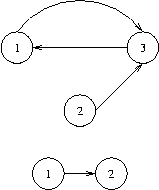【图论】The Bottom of a Graph
[POJ2553]The Bottom of a Graph
| Time Limit: 3000MS | Memory Limit: 65536K | |
| Total Submissions: 11182 | Accepted: 4608 |
Description
We will use the following (standard) definitions from graph theory. Let V be a nonempty and finite set, its elements being called vertices (or nodes). Let E be a subset of the Cartesian product V×V, its elements being called edges. Then G=(V,E) is called a directed graph.
Let n be a positive integer, and let p=(e1,...,en) be a sequence of length n of edges ei∈E such that ei=(vi,vi+1) for a sequence of vertices (v1,...,vn+1). Then p is called a path from vertex v1 to vertex vn+1 in G and we say that vn+1 is reachable from v1, writing (v1→vn+1).
Here are some new definitions. A node v in a graph G=(V,E) is called a sink, if for every node w in G that is reachable from v, v is also reachable from w. The bottom of a graph is the subset of all nodes that are sinks, i.e., bottom(G)={v∈V|∀w∈V:(v→w)⇒(w→v)}. You have to calculate the bottom of certain graphs.
Let n be a positive integer, and let p=(e1,...,en) be a sequence of length n of edges ei∈E such that ei=(vi,vi+1) for a sequence of vertices (v1,...,vn+1). Then p is called a path from vertex v1 to vertex vn+1 in G and we say that vn+1 is reachable from v1, writing (v1→vn+1).
Here are some new definitions. A node v in a graph G=(V,E) is called a sink, if for every node w in G that is reachable from v, v is also reachable from w. The bottom of a graph is the subset of all nodes that are sinks, i.e., bottom(G)={v∈V|∀w∈V:(v→w)⇒(w→v)}. You have to calculate the bottom of certain graphs.
Input
The input contains several test cases, each of which corresponds to a directed graph G. Each test case starts with an integer number v, denoting the number of vertices of G=(V,E), where the vertices will be identified by the integer numbers in the set V={1,...,v}. You may assume that 1<=v<=5000. That is followed by a non-negative integer e and, thereafter, e pairs of vertex identifiers v1,w1,...,ve,we with the meaning that (vi,wi)∈E. There are no edges other than specified by these pairs. The last test case is followed by a zero.
Output
For each test case output the bottom of the specified graph on a single line. To this end, print the numbers of all nodes that are sinks in sorted order separated by a single space character. If the bottom is empty, print an empty line.

Sample Input
3 3 1 3 2 3 3 1 2 1 1 2 0
Sample Output
1 3 2
Source
题目大意:输出有哪些点在有向图中满足它能到达的点都可以到它
试题分析:缩点后输出出度为0的强联通分量中的点即可。
代码:
#include<iostream>
#include<cstring>
#include<cstdio>
#include<vector>
#include<queue>
#include<stack>
#include<algorithm>
using namespace std;
inline int read(){
int x=0,f=1;char c=getchar();
for(;!isdigit(c);c=getchar()) if(c=='-') f=-1;
for(;isdigit(c);c=getchar()) x=x*10+c-'0';
return x*f;
}
const int MAXN=5101;
const int INF=999999;
int N,M;
vector<int> vec[MAXN];
bool inq[MAXN];
int que[MAXN];
int dfn[MAXN],low[MAXN];
int tar[MAXN];
bool oud[MAXN];
int tot,Col,tmp;
void Tarjan(int x){
tot++;
dfn[x]=low[x]=tot;
que[++tmp]=x;
inq[x]=true;
for(int i=0;i<vec[x].size();i++){
int to=vec[x][i];
if(!dfn[to]){
Tarjan(to);
low[x]=min(low[x],low[to]);
}
else if(inq[to]) low[x]=min(low[x],dfn[to]);
}
if(dfn[x]==low[x]){
++Col; tar[x]=Col;
inq[x]=false;
while(x!=que[tmp]){
int k=que[tmp];
tar[k]=Col;
inq[k]=false;
tmp--;
}
tmp--;
}
return ;
}
vector<int> vec2[MAXN];
int ans[MAXN];
int ans2[MAXN];
int atmp,atmp2;
int main(){
while(1){
N=read(); if(!N) break;
M=read();
memset(inq,false,sizeof(inq));
memset(oud,false,sizeof(oud));
atmp=atmp2=0;
memset(dfn,0,sizeof(dfn));
tmp=0,Col=0,tot=0;
memset(tar,0,sizeof(tar));
for(int i=1;i<=N;i++) vec[i].clear(),vec2[i].clear();
for(int i=1;i<=M;i++){
int u=read(),v=read();
vec[u].push_back(v);
}
for(int i=1;i<=N;i++) if(!dfn[i]) Tarjan(i);
for(int i=1;i<=N;i++){
//size[tar[i]]++;
vec2[tar[i]].push_back(i);
for(int j=0;j<vec[i].size();j++){
if(tar[i]!=tar[vec[i][j]])
oud[tar[i]]=true;
}
}
for(int i=1;i<=Col;i++){
if(!oud[i]) ans[++atmp]=i;
}
for(int i=1;i<=atmp;i++){
for(int j=0;j<vec2[ans[i]].size();j++){
ans2[++atmp2]=vec2[ans[i]][j];
}
}
sort(ans2+1,ans2+atmp2+1);
for(int i=1;i<atmp2;i++) printf("%d ",ans2[i]);
printf("%d\n",ans2[atmp2]);
}
}
你——悟到了么?


 浙公网安备 33010602011771号
浙公网安备 33010602011771号